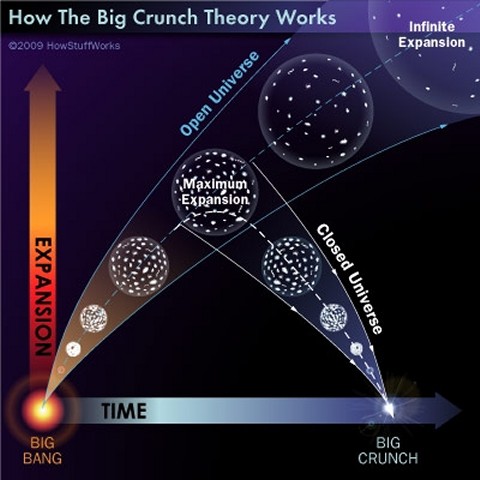When thinking about the Universe and looking at the sky, a natural question comes to everyone’s mind: how did all of this begin?
It is today commonly accepted that everything started with the Big Bang, a primordial explosion from which the Universe we see today has expanded.
On the other hand, you might wonder how the Universe will end; we don’t have a definitive answer to that question, though there is a limited number of possibilites. Some of them are more likely to happen than others, the fate of the Universe being intimately linked to its shape (see the article The shape of the Universe for further details).
The Big Crunch
The Big Crunch is probably the best-known of all the possible fates of our Universe. In this scenario, the expansion of the Universe is slowed down by the mutual gravitational pull of all its matter. Eventually all matter would collapse into black holes, which would then coalesce, producing a unified black hole or Big Crunch singularity.
According to observations, the expansion of the Universe is currently accelerating, which makes the scenario of a Big Crunch improbable. However, the acceleration is driven by dark energy, the nature of which is unknown: we have no idea if the effect of dark energy is of a constant nature, or evolving with time. There are even alternative explanations to the existence of dark energy, as we cannot be definitely sure it exists – I personally have doubts about its existence, but it is not the matter here – so it is still possible that the Universe might end in a Big Crunch.
The Big Bounce
In the Big Bounce scenario, the Big Bang would not be the beginning, but rather the result of the collapse of a previous Universe: our Universe would then expand, and later undergo a Big Crunch, before it expands again, and so on.
Such a model is called a cyclic or oscillatory model, and it comes with a problem: the second law of thermodynamics. According to that law, the entropy (a measure of «disorder») of an isolated system can only increase; thus, successive cycles would grow longer and larger. So, if you go back in time, cycles before the present one are getting shorter and smaller, back to a Big Bang as an origin. However, thanks to phantom energy, a particular form of dark energy, such scenarios remain possible (that is the «nice» aspect of this dark energy, you can do almost anything with it…), though highly improbable.

The Big Rip
There is another scenario allowed by phantom energy: the Big Rip. In a phantom energy dominated Universe, the Universe expands at an ever increasing rate; eventually, all the matter of the universe is progressively torn apart by the expansion. This would result in a complete absence of interaction between different parts of the Universe, they are «ripped» apart. Galaxies would be first separated from each other, then galaxies themselves would be ripped apart, followed by stellar systems, stars, planets, and finally atoms. The Universe would end in a singularity, as the dark energy density and expansion rate become infinite.
As for the Big Bounce scenario, since dark energy is not growing in strength, the Big Rip seems to be the least probable scenario.
However, given that the theory of inflation is commonly accepted, a huge uncertainty remains regarding the equation of state of dark energy… Indeed, according to the theory of inflation, the Universe underwent a short period of extremely rapid expansion, driven by a different form of dark energy than the present one. Assuming the theory of inflation is right, there is then no way to claim that the equation of state of dark energy will not change again.
The Big Freeze
The Big Freeze, also known as Heat Death, is the most widely accepted possible scenario for the fate of the Universe. The Big Freeze is the direct consequence of an ever expanding Universe: this results in a universe asymptotically approaching the absolute zero temperature. The term Heat Death refers to the idea that when the Universe reaches its maximum entropy (according to the second law of thermodynamics previously mentioned), everything will be evenly distributed, preventing any form of information processing: the observable Universe will keep shrinking to the point all galaxies beyond our local group will not be visible; all the stars will die, black holes will disintegrate, and finally protons will decay. Only electrons remain in a completely dark Universe and the temperature approaches the absolute zero: all mechanical motion stops.
As you probably noticed, in all the possible scenarios, we are facing a problem: dark energy. As long as we don’t have a better understanding of dark energy (or build satisfactory cosmological models in which it is not needed), we will not be able to predict the fate of our Universe.


